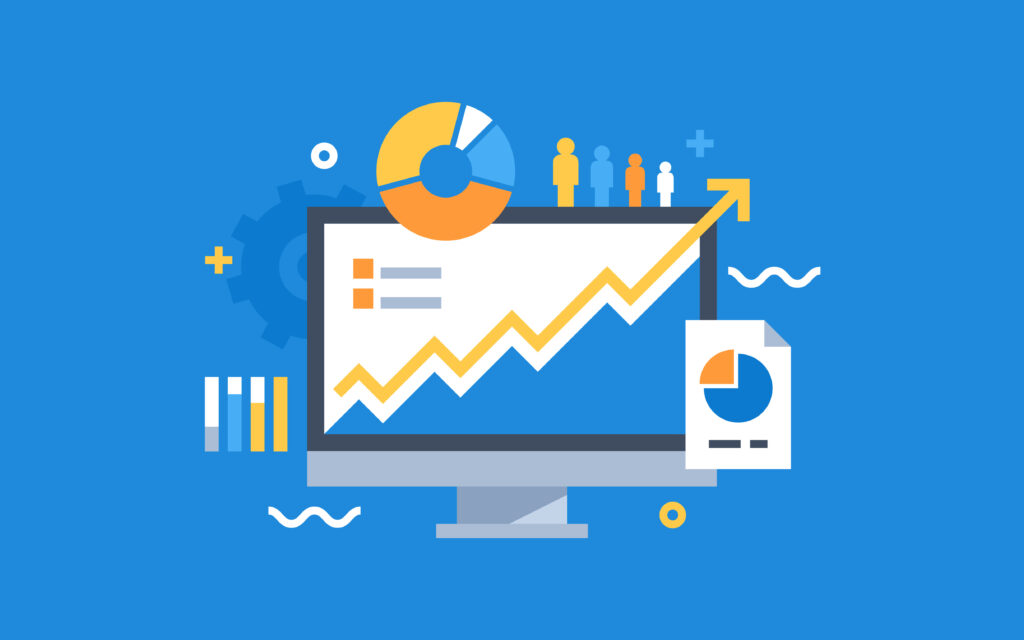Nucleus Research found that companies that implemented BI and analytics saw an average ROI of $13.01 for every dollar invested.
Business Intelligence (BI) has revolutionized the way organizations make decisions by providing them with real-time, data-driven insights. In today’s fast-paced and highly competitive business environment, having access to accurate, relevant and up-to-date information is essential for making informed decisions that drive growth and success.
The Hype About Business Intelligence
Okay, So Now You’re Hyped, But What’s the Value?
How BI Differs From Big Data and Data Analytics
How You Can Effectively Use BI To Drive Growth And Innovation
Challenges And Best Practices In Adopting BI
Overcoming Challenges and Successfully Implement A BI Platform

the Hype About Business Intelligence
The use of Business Intelligence (BI) and analytics has become a major driver of business decisions in the United States and has resulted in significant economic benefits. According to a study by Emergen Research, the global market for BI and analytics software was valued at $27.2 billion in 2019, and is expected to grow to $60.5 billion by 2027. In the United States alone, the market for BI and analytics was estimated to be worth over $7 billion in 2020.
Investing in BI and analytics has been shown to provide organizations with a significant return on investment (ROI). A study by Nucleus Research found that companies that implemented BI and analytics saw an average ROI of $13.01 for every dollar invested. This demonstrates the significant impact that BI and analytics can have on an organization’s bottom line.
Overall, the use of BI and analytics to drive business decisions has resulted in significant economic benefits for organizations of all sizes, across a variety of industries. As the availability of data continues to increase, and the capabilities of BI and analytics tools continue to evolve, it is likely that these benefits will only continue to grow in the years to come.

Ok, so now your hyped, but what's the value?
Improved Decision Making
BI provides organizations with the ability to turn data into actionable insights, allowing them to make better decisions based on accurate and up-to-date information.
Increased Operational Efficiency
BI can help organizations streamline processes and identify inefficiencies, leading to increased efficiency and cost savings.
Enhanced Customer Insights
BI provides organizations with a deeper understanding of their customers, including their behavior and preferences, which can be used to improve customer satisfaction and loyalty.
Better Strategic Planning
BI can help organizations make informed strategic decisions by providing them with a clear picture of their market, competition, and performance trends.
Increased Competitiveness
BI gives organizations a competitive advantage by providing them with a more complete and accurate picture of their business, allowing them to make informed decisions and respond quickly to market changes.
Improved Data Quality
BI can help organizations ensure the accuracy and completeness of their data, leading to improved data quality and confidence in decision-making.
Greater Collaboration
BI provides a centralized platform for information sharing and collaboration, allowing teams to work together more effectively and make decisions more quickly.
Better Risk Management
BI can help organizations identify and mitigate potential risks by providing them with real-time insights into their operations and performance.

The Guts of BI
BI encompasses a vast array of components and systems, aimed at providing organizations with the ability to make informed decisions by leveraging data. The components of a typical BI system include data warehouses, data marts, ETL/ELT (extract, transform, load) processes, OLAP (Online Analytical Processing) cubes or tabular datasets, dashboards, reports, and predictive analytics models.
These components work together to collect, store, process, analyze, and present data in a meaningful way, enabling businesses to gain insights into their operations and make data-driven decisions.
The BI landscape is constantly evolving, with new tools and technologies emerging to make it easier and more effective to turn data into actionable insights.
Data Warehousing
A centralized repository for storing and managing large amounts of data from various sources.
ETL/ELT (Extract, Transform, Load) processes
Tools used to extract data from various sources, transform it into a standard format, and load it into the data warehouse.
Data Marts
Smaller, more focused data stores that provide quick access to specific subsets of data.
OLAP (Online Analytical Processing) Cubes
Data structures that enable fast and efficient querying and analysis of data.
Dashboards
Graphical representations of data that provide a real-time overview of key metrics and KPIs (Key Performance Indicators).
Reports
Pre-defined or ad-hoc reports that provide detailed insights into specific areas of data.
Predictive Analytics Models
Statistical models that use historical data to make predictions about future trends and outcomes.
Collaboration and communication tools
Tools that enable BI stakeholders to collaborate, share insights, and make data-driven decisions.

How BI differ from Big Data and Data Analytics?
BI and Big Data are often used interchangeably, but they refer to different concepts. BI is a set of technologies, tools, and practices that enable organizations to transform data into actionable insights for decision-making purposes. Big Data refers to the massive volume of structured and unstructured data that organizations generate from various sources, such as social media, IoT devices, and transactional systems.
Data Analytics, on the other hand, is the process of examining and analyzing data to uncover patterns, correlations, and other insights that can inform decision-making. While BI and Data Analytics share some common elements, they have different goals and approaches. BI focuses on delivering insights to support decision-making and operations, while Data Analytics is more focused on exploring data and discovering new insights.

popular tools used for BI
Don’t take my word for it! Gartner, a leading research and advisory company, releases an annual ranking of leading BI and Analytics platforms based on comprehensive research methodologies. Based on the 2022 Gartner Magic Quadrant, the best and most popular BI platforms include:
Power BI
A cloud-based BI platform that provides real-time data insights and enables organizations to share and collaborate on insights with others.
Tableau
A data visualization tool that enables organizations to create interactive dashboards, reports, and visualizations.
QlikView
A self-service BI tool that provides users with the ability to explore data and create interactive dashboards and visualizations.
SAP Business Objects
A comprehensive BI solution that provides organizations with a wide range of data analysis, reporting, and visualization tools.
IBM Cognos Analytics
An AI-powered BI platform that enables organizations to explore and visualize data, and collaborate on insights with others.

How you Can Effectively Use BI to Drive growth and innovation
Business Intelligence (BI) can play a critical role in driving growth and innovation for organizations by providing insights that inform decision-making and support data-driven strategies. To effectively use BI for growth and innovation, organizations can follow the following steps:
Establish a clear strategy
Organizations should have a clear understanding of how they want to use BI to drive growth and innovation and define their goals and objectives.
Invest in the Right Technology
Organizations should invest in BI tools and technologies that can support their goals and requirements, and ensure that they have the right infrastructure to support the data needed for BI.
Clean and Standardize Data
To ensure that BI insights are accurate and reliable, organizations should clean and standardize their data to eliminate errors and inconsistencies.
Foster a Data-Driven Culture
Organizations should create a culture that values data and insights, and encourage employees to use BI tools and insights to inform their decision-making.
Continuously Monitor and Refine
Organizations should continuously monitor their BI efforts and refine their approach as needed, to ensure that they are maximizing the value of their data and insights.

Challenges and Best Practices in Adopting BI
There are several challenges that organizations may face when implementing a Business Intelligence (BI) platform, including:
Data quality and integration
Ensuring that data is accurate, consistent, and properly integrated can be a challenge, especially if the organization has multiple sources of data.
User Adoption
Getting users to adopt and effectively use the BI platform can be a challenge, especially if they are not familiar with the technology or if the platform is not user-friendly.
Integration with Existing Systems
Integrating the BI platform with existing systems and processes can be a challenge, especially if the organization has legacy systems or complex data architecture.
Data security and privacy
Ensuring that data is secure and private can be a challenge, especially when dealing with sensitive data.

Overcome Challenges and Successfully Implement a BI platform!
Establish a Clear Strategy
Organizations should have a clear understanding of how they want to use BI and define their goals and objectives.
Clean and Standardized Data
Organizations should clean and standardize their data to ensure that BI insights are accurate and reliable.
Foster a Data-Driven Culture
Organizations should create a culture that values data and insights and encourage employees to use the BI platform to inform their decision-making.
Continuously Monitor and Refine
Organizations should continuously monitor their BI efforts and refine their approach as needed, to ensure that they are maximizing the value of their data and insights.
Involve all Stakeholders
Organizations should involve all stakeholders in the BI implementation process, including business users, IT, and data management teams, to ensure a successful implementation.

The Wrap
Business Intelligence (BI) has become an essential tool for organizations looking to make informed decisions and drive growth and innovation. By providing real-time data insights and visualization, BI platforms help organizations to identify trends, opportunities, and risks, and make data-driven decisions. The future of BI looks promising, with the growing demand for real-time insights and the increasing importance of data-driven decision making.
Additionally, advancements in technology are likely to continue to drive innovation in the BI space, providing organizations with even more powerful tools to gain a competitive advantage and succeed in today’s rapidly changing business environment. As data becomes increasingly central to business success, the future of BI looks bright and organizations that adopt BI will be well-positioned to thrive in the years to come.

One Response
Hi, this is a comment.
To get started with moderating, editing, and deleting comments, please visit the Comments screen in the dashboard.
Commenter avatars come from Gravatar.